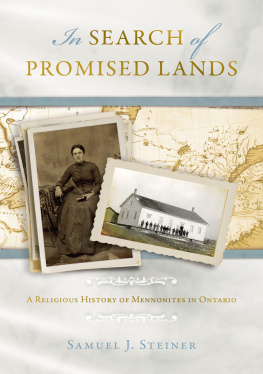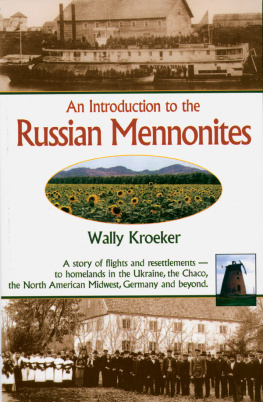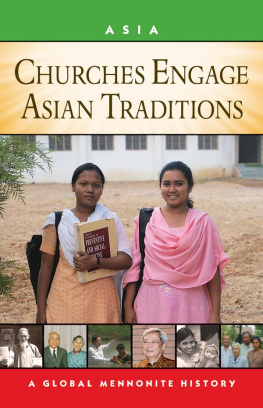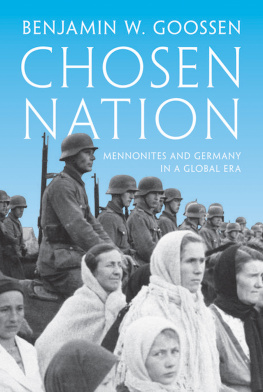In SEARCH of
PROMISED LANDS
Samuel J. Steiner tells the story the numerous strains of Amish and Mennonite people in In Search of Promised Lands. Steiner covers the Mennonites numerous institutions and also the Old Order parochial schools; he brings to the readers attention of Russian Mennonite migrations, but neither does he overlook the East Asian refugee assistance. For a devoted historian, the extensive endnotes add a wealth of information and credibility to the book. Like the story of the Israelites, In Search of Promised Lands includes the Mennonites quest for an earthly home as well as their heavenly abode.
Donald Martin, Old Order Mennonite historian
We members of the Mennonite Historical Society of Ontario have had the privilege of walking with Sam as this book took shape. As he finished certain segments he would do a presentation at our annual meeting, followed by a bus tour of the pertinent sites. This helped to put the various stories into context and whetted our appetites to see the book completed as a comprehensive documentation of Ontario Mennonite history, with all its rich diversity.
Maurice Martin, president, Mennonite Historical Society of Ontario
Sam Steiners account of the Mennonite story in Ontario is objective, thorough, and engaging. His careful attention to detail is a personal tribute to the variety of Mennonite groups that call Ontario home. I highly recommend In Search of Promised Lands to anyone desiring to understand the Mennonite story in Ontario, and as an example of how Mennonite histories should be written.
Richard D. Thiessen, managing editor, Global Anabaptist Mennonite Encyclopedia Online
In Search of Promised Lands is a great contribution to our Mennonite people! It covers the many Mennonite and Amish groups, churches, schools, and cultures from the early years to the latest immigrations. Much research has gone into this valuable book. This will be a priceless resource for all readers and archivists.
Walt Koop, chair, Essex Kent Mennonite Historical Association
Steiners careful research, archival depth, breadth of coverage, thematic coherence, respectful candor, and useful summations make this book not only a treasury of Ontario Mennonite memory but a valuable companion to Mennonite history across North America.
John L. Ruth, author of The Earth Is the Lords: A Narrative History of the Lancaster Mennonite Conference
This is a remarkable book! Encyclopedic in scope and traversing three centuries, In Search of Promised Lands provides a lively account of the astounding ecclesial and ethnic diversity among Mennonite and Amish groups in Ontario. Though anchored firmly in the rich farmland and bustling towns of Ontario, this book is relevant for the entire North American churchwe all will find a part of our story here!
John D. Roth, editor of Mennonite Quarterly Review

Library and Archives Canada Cataloguing in Publication
Steiner, Samuel J., author
In search of promised lands: a religious history of Mennonites in Ontario / Samuel J. Steiner.
(Studies of Anabaptist and Mennonite history series; 48)
Includes bibliographical references and index.
ISBN 978-0-8361-9908-6 (bound)
1. Mennonites--Ontario--History. 2. Ontario--Church history.
I. Title. II. Series: Studies of Anabaptist and Mennonite history
series; 48
FC3100.M45S74 2015 289.7713 C2014-904309-0
IN SEARCH OF PROMISED LANDS
Copyright 2015 by Herald Press
Published in Canada by Herald Press, Kitchener, Ontario N2G 3R1
Released simultaneously in the United States of America by Herald Press,
Harrisonburg, Virginia 22802. All rights reserved.
Library of Congress Control Number: 2014942808
Canadian Entry Number: C2014-904309-0
International Standard Book Number: 978-0-8361-9908-6
Printed in Canada
Cover design by Reuben Graham, design by Reuben Graham
Cover photo at left: Janet Douglas, first woman to pastor a Mennonite congregation in Ontario, in 1885 (Missionary Church Archives, Bethel College, Mishawaka, Indiana). Cover photo at right: Christian Eby meetinghouse in Berlin (Kitchener), Ontario, ca. 1900 (Mennonite Archives of Ontario). Map: iStock/Thinkstock
Photos and illustrations used in this book are used by permission, and their sources are given with each caption.
All rights reserved. This publication may not be reproduced, stored in a retrieval system, or transmitted in whole or in part, in any form, by any means, electronic, mechanical, photocopying, recording, or otherwise without prior permission of the copyright owners.
Unless otherwise indicated, all Bible quotations are from The Holy Bible, King James Version.
To order or request information, please call 1-800-245-7894 or visit www.heraldpress.com.
19 18 17 16 15 10 9 8 7 6 5 4 3 2 1
For Sue Clemmer Steiner, who in 1968
convinced me that Canada was the promised land
Maps and Tables
Maps
Tables
Foreword
The Mennonites in Ontario exhibit a broad range of ethnic diversity: from the Swiss German families that migrated from Pennsylvania in the late 1700s, to the Dutch Russian immigrants fleeing Soviet communism in the early twentieth century, to the Old Colony and Old Order settlements that were established in the mid to late twentieth century, to the new immigrant populations of Hmong, Laotian, Indonesian, Korean, Chinese, and Hispanic people who have become Mennonite in recent decades. Moreover, these ethnic differences are inflected across a broad spectrum of spiritual and cultural forms: from traditionalist withdrawal to conservative boundary maintenance to evangelical renewal to progressive assimilation. How, amid all this diversity, is it possible to discern a coherent picture of the Mennonites who have sojourned in Ontario?
In the story crafted here by Samuel Steiner, Mennonites of all types and backgrounds understood their presence in Ontario as part of the larger story of Gods people on the move from slavery to freedom, from despair to hope, from wilderness wandering to promised land settlement. Even when they could not agree on doctrine, they were bound by the shared hope of salvation, both in its earthly form of peaceable flourishing and in its heavenly form of life eternal. In this way, Ontario Mennonites, like the larger Mennonite people of which they are a part, have been restless and creative in their search for new horizons of spiritual and religious meaning, as well as new opportunities for social and economic thriving.
Readers will discover here the numerous details of material and spiritual culture about which Ontario Mennonites argued and divided. The depicted conflicts often echo decisions and controversies unfolding in Mennonite communities beyond Ontario, demonstrating the deep and persistent ties between Mennonites in Ontario and the struggles and challenges of a larger peoplehood. But the conflicts described are also connected with movements and visions that Mennonites shared with Christian brothers and sisters beyond the Mennonite tradition, from Pietist reform to holiness revival to fundamentalist orthodoxy to ecumenical dialogue to missional church.
The authors own journey is reflected in his telling of the Ontario Mennonite storyseeking a promised land of peace and prosperity beyond the fierce and exhausting conflicts of nations, races, churches, and institutions. As an archivist and a church member, Steiner understands both precisely and existentially the specific historical ways that Ontario Mennonites have been unable to escape the conflicts that characterize all human communities. Yet Steiners narrative helps us see more clearly the colorful and lively horizon of faithfulness that appears when we view the whole panorama of Mennonite diversity in the Ontario regionall the anxious and confident words spoken, roads taken and not taken, and new options established and challenged through the earnest and sometimes costly choices of a people seeking to follow Jesus Christ in life.










